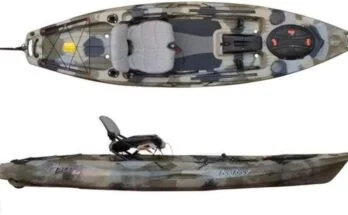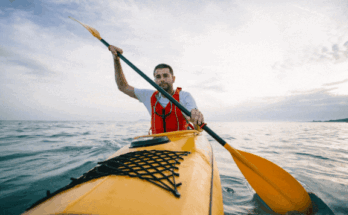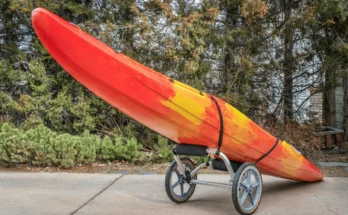You can be aware that (almost”) a kayak weight limits often includes its own weight. Here it is—this formula will help you see what you need to do to achieve its maximum level of operation.
One of the potential items that you may pursue to know before heading to go out for a kayaking adventure is about its specified capacity.
It seems straightforward, right? Nevertheless, the ability to weigh including the weight of your kayak may not be common knowledge.
In this paper, the mystifying phenomenon of the kayak weight limits how they are understood and calculating the performance limit will be summarized.

Various Type of Kayak and their Carrying Capacity is Varying.
Amongst different styles of kayaks as well, Kayak weight limits capacity is usually dependent on intended purpose like for example.
Generally, recreational kayaks’ are rated to carry between 250 to 300 pounds. A sit-on-top kayak weight limits capacity may vary between 350 and 400 pounds, depending on the boat manufacturer. Taking multi-person interval kayaks of average 350-pound kayak weight limits, tandem ones will usually have the highest weight limit, which varies from 500 to 600 pounds.
Do I have several specifics and benefits of one option in mind? Read our guide that covers kayak types and find the one that fits you.
The Real Interpretations of Comfort and Functionality Level in Kayak Suggested Kayak Weight Limits
A mistake we sweat is, for example, a kayak specified as suitable for weights up to 250 lbs which makes you believe it is a perfect kayak for a person weighing 250 lbs.
It’s not that simple.
The heaviest weight a kayak can carry on top of the buoyancy level is the kayak weight limits maximum. It is important not to forget to add up your weight, the weight of any accessories hiking equipment, and the weight of the craft itself.
Which Weight Capability Is the Most Reliable?
It is worth mentioning that manufacturers, e.g. Old Town, have introduced a new metric called “useable weight capacity.” This features the actual weight one can put into the kayak, excluding the kayak itself and even though the terms varies.
Serviceable load capacity works more closely in gaging the load ability of kayaks. For eg. Kayaks that have a load limit of 300 pounds and have a weight of 40 pounds provide a usable capacity of 260 pounds.
On this note, you want to keep below 260 pounds maximum weight on the hiking pole, including your body weight and all gears you are carrying along with you.
Fulfilling this role requires dedication and commitment, which are admirably executed by the Old Town. They were among the first among the mass shoppers who have distinctly separated between a kayak weight limits and its usable weight capacity.
They’re able to give explicit details both their products and simultaneously establish a benchmark for transparency and sense of security. Firstly, it makes people to be informed, and secondly it may serve as a pattern for other producers to copy.

Calculating the Performance Weight Limit
For those who want to ensure optimal performance, there’s a handy formula to keep in mind: the performance weight limit is determined by the airplane weight capacity, which is 75% of the usable weight capacity. And, as per way the given example shows, 75% share of 260 pounds is 195 pounds (260 X 0.75).
This designates the weight tolerance for the best kayaking experience, which is to not exceed 180 pounds (you plus your stuff) on that kayak.
It is this that enables the craft remain stiff, paddled easily and at the least chance of being filled by the incoming waves or tipping over.
Knowing your own weight and the taken weight of your equipment, divide it by 0.25 and get a capacity number, which has to be added to the kayak’s weight.
For best performance, the total should equal the same or less than the stated kayak weight limit in the manufacturer’s conditions.
Answers for the cases you go past the kayak’s weight capacity.
Stuffing an overloaded kayak beyond its weight capacity is bound to set a lot of challenges well-informed with adverse consequences.
The waterline of every kayak is defined as the point up to which it can be filled with water for it not to take on water when loaded.
You have to add weight as you get more and more and you get the water line to shift higher with the sinking of the kayak. And what if the load becomes even heavier?
Here’s a quick video showcasing the stark difference in performance and safety among a kayak within its weight limit and an overloaded one:
- Reduced Stability: It becomes difficult to maintain balance of a tired kayak that is full to the top. It is ability of kayaks to overturn or capsize that makes its users to be most exposed in choppy water or making sharp turns.
- Compromised Maneuverability: As a kayak is submerged deeper inside the water, it gets harder to boat to keep the direction it is intended to. In such an environment in a strong stream of water or considerable wind it may be difficult.
- Decreased Speed: A kayak water is slowed down by a oversupplying of excess burden. In addition to this you will find it a bit tough to excel at the required strength and consequently you are likely to become out of breath.
- Water Ingress: Aggravate for water to splash easily over the walls is going beyond the weight capacity or entering through any scupper holes. There are two layers of bad effects here: getting wet and very uncomfortable as the water steepens into your kayak that was already overloaded.
- Strain on the Kayak: When you exceed the specified weight limit by overloading your kayak, the hull’s structure will be under extreme strain and might get damaged or could even lead to a breakage.
- Potential for Sinking: In severe cases, being overloaded might not just of warping the kayak body, but indeed sinking the kayak might be its destiny. While the concepts of Cockroaches and topics of migration in “The Metamorphosis” are contrasting, both display that change has to occur for selfless commitment to a higher cause. This idea is discussed in the story that things we don’t understand may just allow us to be more compassionate.
Different Kayaks, Different Reactions
It is not the case that all kinds of kayaks reply the same way when over sailing;
however. For instance:
Sit-on-Top Kayaks: These are usually of much tougher nature, if they hit showers or storms along the way. They are also fitted with scupper hole pipes that water can come through if the prevailing weight does so as to push down below the water line.
Sit-Inside Kayaks: Drowning could happen if the water is rushing over the cockpit’s rim. Moreover, canoes do not have bulkheads above the waterline, making them vulnerable to sinking.
When water is coming in, it can be in a spiral cycle of increased weight up, and then less buoyancy.
Increasing Kayak Weight Limits: Myth vs. Reality
Today in the ocean of kayaking, kayaking continues to hold some popular myths and misconceptions. The fact is that a kayak will continue to have the same kayak weight limits indefinitely it doesn’t matter what you do. There are some furnishings and construction that can improve stability but it happens under certain bounds and kayak’s lifting capacity will not exceed those restrictions.

Kayak Outriggers: A Bladed Protagonist
For many kayakers, outriggers are another popular option. They are among the means to lift the weight of a kayak. This however was not the situation.
Their benefits:
- Enhanced Stability: Yes, outriggers extend kayak’s stability factor and are helpful even in choppy waters or for standing up to do activities like fishing.
- Confidence Boost: For beginners or people who may be still uneasy or shy about tipping, outrigger can help you gain a greater sense of protection
Their limitations:
- No Increase in Weight Limit: Even though the outriggers make a wooden canoe seem more stable, this doesn’t impact the wooden canoe’s weight limit. The kayak can still sink or you might end up with a structural defect by overloading the craft before its capacity.
- Potential Drag: Outriggers act kind of like additional drag in the water on the kayak bringing its speed down and provoked the need to really get into the paddling thing along bigger distances.
- Complexity: Mounting and getting around with kayak outriggers could also increase the difficulty of your kayaking preparation as well as the experience.
In summary, Not only the engine but the weight distribution of the vehicle plays a vital role in the fuel efficiency.
Don’t think just in terms of the capacities nature of the kayak’s load although the peculiar cp Location of the load is as important. A weight fully balanced reduces friction when moving, creates smooth maneuverability, and provides optimum stability.
The Art of Weight Distribution
Heavier items must be placed in the center and lower part of the kayak to avoid the kayak from capsizing. See the seating position to changes if it is the need, and the equilibrium of the kayak is adjusted by slowly switching the kayak by the sides.
But if you are getting ready for a long tour, which may be a week or more, then that’s another story, you might be on a camping adventure. Which is also by the way another building layer of complexity.
At the same time, you should also take into account your gear’s weight, size and shape. Both of these aspects will also have to be taken into consideration. For a more extensive look at this matter, carefully follow our extended manual on kayak packing for camping.
The fact that your weight is a separate feature and so is your kayaking, makes it related to be a distinct feature also in kayaking.
Well, the realm of kayaking as such is complex, with a lot of choices that exist in different variants and varieties but are suitable for diverse body shapes, skill levels, and aspirations.
Whether you are a featherweight person or growing larger, there is a kayak which will be optimal for both you and your body. But how do you pick up one which is best suited for you?

CONCLUSION
Then, remember the weight you need to carry and spare weight of the gear you plan to take along. This will give you an idea of the entry level, which will then be the basis for discussion to determine what exactly the job will entail.
Next, enter the theme about kayak weight limits. As we have already found out, the topic of discussion is not confused with the maximum weight that kayak can handle.
It is here that it is value remember, weight capacity of the kayak, its maximum kayak weight limits, and its presentation weight limit.
For those who prefer a more straightforward approach, we’ve characterized some top recommendations based on the kayak weight limits:
Best 300 lb Capacity Kayaks: Ideal for those who fall within the average weight range, these kayaks offer a balance of constancy and maneuverability.
Best 400 lb Capacity Kayaks: For those with a more robust build or those who like to pack a lot of gear, these kayaks provide ample space and support.
Best 500 lb Capacity Kayaks: These are the durable options, perfect for tandem kayaking or extended trips with lots of equipment.




